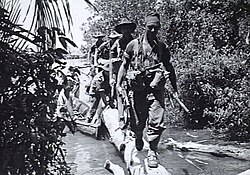| Battle of North Borneo | |||||||
|---|---|---|---|---|---|---|---|
| Part of Pacific theatre of the Second World War | |||||||
 Members of a patrol from 'A' Company, Australian 2/43rd Battalion, disembark from a boat and walk along a large fallen tree, as they move inland to investigate reports of Japanese activity. | |||||||
| |||||||
| Belligerents | |||||||
|
|
| ||||||
| Commanders and leaders | |||||||
|
|
| ||||||
| Units involved | |||||||
|
| |||||||
| Strength | |||||||
| ≈29,000–30,000 men | ≈8,800 men (Allied estimate) | ||||||
| Casualties and losses | |||||||
|
114 killed or died of wounds 221 wounded |
At least 1,234 killed 130 captured | ||||||
The Battle of North Borneo took place during the Second World War between Allied and Japanese forces. Part of the wider Borneo campaign of the Pacific War, it was fought between 10 June and 15 August 1945 in North Borneo (later known as Sabah). The battle involved a series of amphibious landings by Australian forces on various points on the mainland around Brunei Bay and upon islands situated around the bay. Japanese opposition to the landings was sporadic initially, although as the campaign progressed a number of considerable clashes occurred and both sides suffered significant casualties, although major combat was largely restricted to Labuan and around Beaufort. On the mainland, while Allied conventional operations focused largely on the coastal areas around Brunei Bay, guerrilla forces consisting of Dayak tribesmen and small numbers of Allied personnel from the Services Reconnaissance Department fought an unconventional campaign in the interior. The Allies were successful in seizing control of the region. Nevertheless, many of the strategic gains that possession of North Borneo provided were ultimately negated by the sudden conclusion of the war in August 1945.